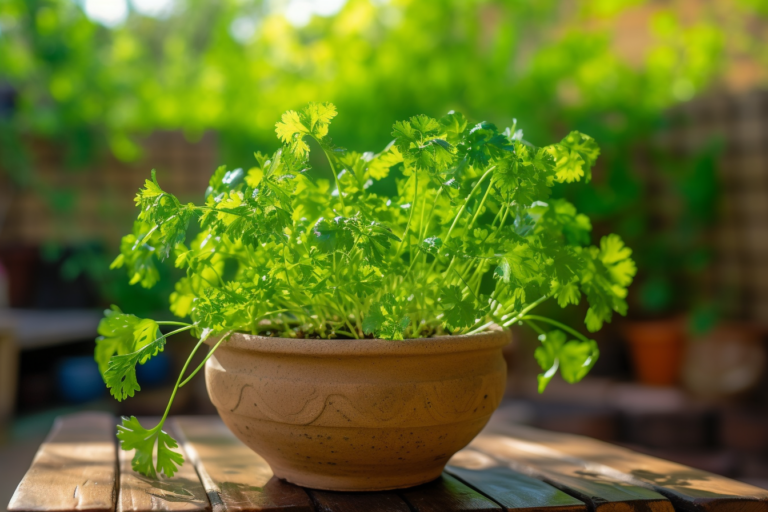Cilantro is a staple in many kitchens around the world. Its unique flavor adds depth and character to dishes. But have you ever wondered about the journey it takes from seed to your dinner plate? As with most plants, proper watering is crucial to cilantro’s healthy growth. But how often should you water cilantro? Let’s find out.
The Importance of Proper Watering
Cilantro, like all plants, requires an optimal balance of water. Just as we need hydration to survive and thrive, so does cilantro. But remember, too much or too little water can lead to detrimental effects on cilantro’s health.
Identifying Your Cilantro’s Watering Needs
The key to knowing how often to water cilantro lies in understanding its watering needs. Cilantro prefers moist but well-drained soil. It doesn’t enjoy being waterlogged or dried out, so it’s essential to strike a balance.
How Often to Water Cilantro?
Generally, cilantro needs watering every 3 to 5 days, depending on the climate and soil conditions. However, always check the soil’s moisture level before watering. If the soil is dry 1 to 2 inches beneath the surface, it’s time to water your cilantro.
Factors that affect how often you should water cilantro
Cilantro is a fragrant herb with delicate leaves that is used in many cuisines around the world. Proper watering is essential to keep the plant healthy and flavorful. However, how often you should water cilantro depends on several factors.
Climate and temperature
The climate and temperature at your location play a crucial role in determining how often you should water cilantro. In warmer and drier climates, the plant may require more frequent watering than in colder and humid regions.
Soil type and drainage
The soil type and drainage in your garden also affect how often you should water cilantro. The herb prefers well-draining soil that does not retain water. Overwatering in heavy soil can lead to root rot and other fungal diseases, whereas under-watering in sandy soil can cause the plant to wilt.
Age of the plant
The age of the plant also influences how often you should water cilantro. Newly planted seedlings need more frequent watering than established plants. During the germination process, it’s important to keep the soil consistently moist for the first two weeks.
Plant location and exposure to sunlight
The location of the plant and its exposure to sunlight can impact the frequency of watering. Cilantro grown in full sun typically needs more water than those grown in partial shade. Plants grown indoors may require less frequent watering than outdoor ones.
Pot size and type
If you’re growing cilantro in pots, the pot size and type can affect how often you should water the herb. Smaller pots dry out faster than larger ones, and clay pots dry out faster than plastic ones.
Keep in mind that it’s better to underwater cilantro than to overwater it, as the plant can tolerate short periods of drought. A general rule of thumb is to water cilantro when the top inch of soil feels dry to the touch. With the right amount of water at the right time, you can enjoy flavorful cilantro throughout the growing season.
Seasonal Considerations for Watering Cilantro
Seasonal changes influence the frequency of watering cilantro. During warmer months, cilantro might need watering more often due to quicker evaporation. Conversely, in colder months, the watering frequency may decrease due to slower evaporation.
Additional Factors Influencing Watering Frequency
The size of your cilantro plant, the pot’s material, and your geographical location can all affect how often you need to water cilantro. Larger plants in porous containers in dry climates will need watering more frequently.
Common Mistakes to Avoid When Watering Cilantro
It’s crucial to avoid overwatering and underwatering cilantro. Both can lead to various problems, like root rot and wilting. Remember, cilantro doesn’t need to be drenched; it just needs consistent moisture.
The Right Technique for Watering Cilantro
When watering cilantro, aim to water the soil, not the leaves. Watering the leaves can lead to leaf rot or other fungal diseases. So, be gentle and thorough when watering your cilantro.
Cilantro Watering: Indoor vs. Outdoor
Whether your cilantro is growing indoors or outdoors also affects its watering frequency. Indoor cilantro may need less frequent watering than outdoor cilantro due to reduced evaporation.
What Happens If You Overwater or Underwater Cilantro?
Overwatering or underwatering cilantro can lead to a variety of problems, including root rot, wilting, yellowing leaves, and stunted growth. Recognizing these signs early can help you adjust your watering practices in time.
Making Cilantro Watering a Habit
It’s helpful to create a watering schedule based on your cilantro’s specific needs. This way, you can ensure your cilantro receives consistent, adequate hydration, keeping it healthy and thriving.
Why Isn’t My Cilantro Thriving Despite Regular Watering?
Watering is crucial, but it’s not the only factor that affects cilantro’s growth. Factors like sunlight, soil type, and temperature can also play a significant role in your cilantro’s health.
Myths About Watering Cilantro
There are numerous myths about watering cilantro. One such myth is that cilantro needs daily watering. The truth is, watering frequency depends on numerous factors, not a set timetable.
Cilantro Watering Tips for the Busy Gardener
If you’re a busy gardener, consider using tools like self-watering pots or irrigation systems to maintain your cilantro’s optimal moisture levels.
The Frequency of Watering Cilantro in Different Seasons
Cilantro is a popular herb commonly used in many delicious cuisines worldwide. This herb loves moderate amounts of water and thrives well in well-drained, loamy soil.
Watering cilantro isn’t a complicated process, but knowing the right frequency is crucial in its growth and survival. The frequency of watering cilantro varies depending on the season, as different seasons come with different temperatures and humidity levels.
Spring Season
In spring, the temperatures are mild, and the soil is moist, which means cilantro needs watering less often. You can water your cilantro once or twice weekly, depending on the soil’s moisture and the humidity. Keep in mind that overwatering cilantro can lead to root rot; therefore, it’s essential to keep it at moderate levels.
Summer Season
Summer can be brutal on your cilantro. High temperatures, humidity levels, and dry soils can cause your cilantro to wilt and die. To avoid this, you must water your cilantro more often during the summer season. You can water it every two to three days, depending on the soil’s moisture level and humidity.
Fall Season
Fall brings cooler temperatures and low humidity levels, which means that you can cut your watering frequency. You can water your cilantro once a week, mainly if the soil is dry. The cool temperatures during the night will help to retain moisture in the soil.
Winter Season
Winter brings freezing temperatures, and cilantro does not like extremely cold temperatures. If you grow cilantro outdoors, the winter season will kill it. Growing cilantro indoors during the winter season can be a great way to enjoy fresh cilantro all year round. You can water your cilantro once a week, and it needs to receive enough sunlight to grow healthy.
Overall, the frequency of watering cilantro depends on the season, temperature, humidity level, and the soil’s moisture. Always check the soil’s moisture level before watering your cilantro and avoid overwatering. By following these tips, you can enjoy fresh cilantro all year round!
To ensure that your cilantro is properly hydrated, it’s important to test the moisture level of your soil. Here are some quick and easy tips to test the moisture level of your cilantro soil:
- Use your fingers – One of the easiest ways to test the moisture level of your cilantro soil is to use your fingers. Simply insert your finger into the soil up to the second knuckle. If the soil is dry at this depth, it’s time to water your cilantro. If the soil is moist, wait a day or two before checking again.
- Use a moisture meter – If you want a more objective measurement of your soil’s moisture level, consider using a moisture meter. These inexpensive devices can be purchased at any garden center and will give you an accurate reading of your soil’s moisture level.
- Look for wilting – If your cilantro is starting to wilt or look droopy, it’s a sign that it needs water. Be sure to check the soil moisture level using one of the above methods before watering.
It’s important to note that overwatering your cilantro can be just as harmful as underwatering it. Be sure to test the moisture level of your soil before watering and adjust your watering schedule accordingly. A helpful rule of thumb is to water your cilantro deeply once a week and adjust as needed based on the moisture levels of your soil. By following these tips, your cilantro will be healthy and thriving in no time.
Watering Techniques for Cilantro
Proper watering techniques play a vital role in the growth and development of cilantro. Below are some tips to help you water your cilantro effectively:
- Water deeply: Water the plant deeply and slowly to ensure that the water reaches the roots. A general rule of thumb is to water the plant until the top 1-2 inches of soil are moist.
- Water when the soil is dry: Cilantro prefers moist, well-drained soil. It is important to wait until the top layer of soil is dry before watering again. Overwatering not only drowns the plant but can also lead to root rot and other fungal diseases.
- Avoid getting water on the leaves: Try to avoid getting water on the leaves of the plant, as this can cause fungal diseases. Instead, water the soil around the plant.
- Mulch: Adding a layer of organic mulch around the base of the plant can help retain moisture in the soil and reduce the frequency of watering.
- Use a watering can: A watering can is a useful tool for watering cilantro, as it allows you to control the amount of water and directs it to the base of the plant.
By following these techniques, you can ensure that your cilantro receives the appropriate amount of water to maintain healthy growth. Be sure to keep an eye on the soil moisture levels and adjust your watering schedule accordingly.

Conclusion
Cilantro watering is a balance. Understanding your cilantro’s needs and responding accordingly is crucial for its growth and development. Remember, every plant is unique. Listen to your cilantro; it will guide you to its watering needs.


Thanks for this useful guide! I always struggle to know how often to water my cilantro. I usually end up overwatering and killing it. Your tips on checking the soil moisture and using a well-draining pot were really helpful. Can’t wait to try them out and keep my cilantro alive and thriving!